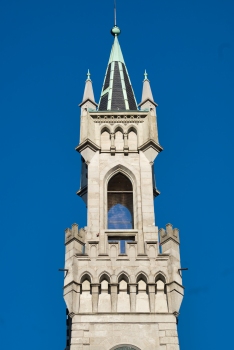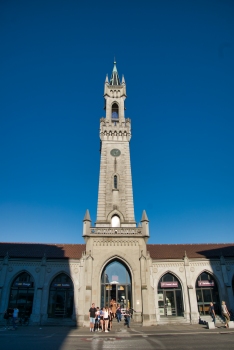General Information
| Completion: | 15 June 1863 |
|---|---|
| Status: | in use |
Project Type
| Function / usage: |
Railroad (railway) station |
|---|---|
| Architectural style: |
Neo-Gothic |
Location
| Location: |
Konstanz, Konstanz (Kreis), Baden-Württemberg, Germany |
|---|---|
| Coordinates: | 47° 39' 32.06" N 9° 10' 37.65" E |
Technical Information
There currently is no technical data available.
Excerpt from Wikipedia
Konstanz station is the largest passenger station in the German city of Konstanz (Constance). It is served by regional and long-distance services operated by Deutsche Bahn and Swiss Federal Railways. It is the end of the High Rhine Railway and the beginning of the Etzwilen–Konstanz line.
History
The station was opened to traffic 15 June 1863 with the opening of the last section of the Upper Rhine Railway between Waldshut and Konstanz by the Grand Duchy of Baden State Railway. The link to Switzerland was opened in 1871, when the Swiss Northeastern Railway (German:Schweizerische Nordostbahn, NOB) opened the line between Romanshorn and Konstanz, now part of the Seelinie ("Lake line"). On 17 July 1875 this was followed by the building of the Etzwilen–Konstanz line, together with the Kreuzlingen–Kreuzlingen harbour connecting line, by the Swiss National Railway (Schweizerische Nationalbahn, SNB). After the SNB went bankrupt in 1878, its tracks were taken over by the NOB. In 1902, the NOB was absorbed in the newly created SBB.
In 1911, the Mittelthurgau-Bahn (MThB) opened a line from Kreuzlingen via Berg and Weinfelden to Wil. From the beginning, services from Kreuzlingen ran on the former SBB line through Konstanz to connect with the German rail network. It was served by the S-Bahn-like Seehas (named after a mythical "lake hare") service developed by the MThB over the Upper Rhine Railway to Engen. In 2002, the MThB fell into financial difficulties and was subsequently liquidated. Since then, subsidiaries of SBB have operated its services: SBB GmbH between Konstanz and Engen and THURBO between Konstanz and Weinfelden/Wil.
Architecture
The station is located on the shore. The station building was built in 1863 in Gothic and Renaissance styles, modelled on the Palazzo Vecchio in Florence. North of the entrance building was the Fürstenbahnhof ("princes’ station building"), a pavilion, which now serves as a shopping centre.
The station has three tracks: a “home” platform (next to the entrance building) and a central island platform. To reach the central platform, tracks 2 and 1 must be crossed on the level. This crossing is protected by a barrier. At the northern end, there is also a tunnel that connects the platforms on one side to the city centre and on the other side to the port. In addition, there are two walkways and a shopping centre leading to the lake.
Structural condition
In the past, Konstanz had a reputation as a "grubby" station, as it was rundown and inefficient. The last major work on the station had been the renovation of the bell tower carried out between 1975 and 1983. As part of the economic stimulus program the entrance building is being rehabilitated with energy-saving measures. The waiting area is also being made more attractive.
Border station
Konstanz has the function of a border station. Before November 2008, when Switzerland became a party to the Schengen Agreement, the central platform was separated by a chain-link fence. Long-distance trains to and from Switzerland stopped on platform 3. The station building also has two sections for the German and Swiss railways. The German part is still operated by Deutsche Bahn and the Swiss part by Thurbo (formerly Mittelthurgaubahn). Travellers to the Swiss section of the station before 2008 had to pass through a customs inspection to get to the platforms.
Text imported from Wikipedia article "Konstanz station" and modified on 29 July 2020 according to the CC-BY-SA 3.0 license.
Participants
- Heinrich Leonhard (architect)
Relevant Web Sites
- About this
data sheet - Structure-ID
20079643 - Published on:
23/07/2020 - Last updated on:
23/07/2020







